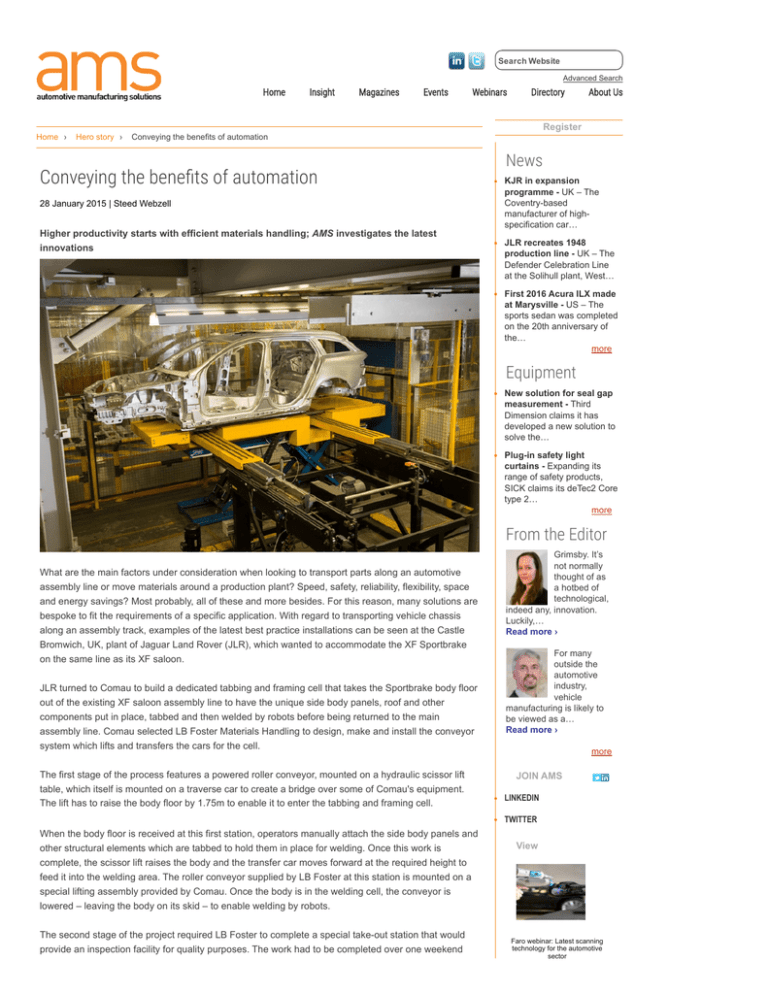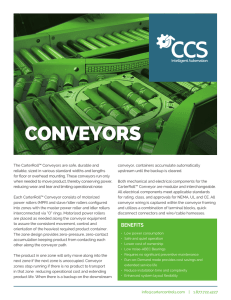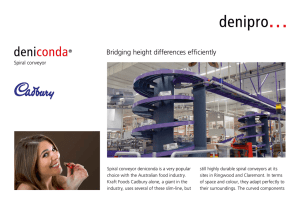Conveying the bene栛쉬ts of automation
advertisement

Search Website Advanced Search Home Insight Magazines Events Webinars Directory About Us Register Home › Hero story › Conveying the benefits of automation Conveying the bene栛쉬ts of automation 28 January 2015 | Steed Webzell Higher productivity starts with efficient materials handling; AMS investigates the latest innovations News KJR in expansion programme ­ UK – The Coventry­based manufacturer of high­ specification car… JLR recreates 1948 production line ­ UK – The Defender Celebration Line at the Solihull plant, West… First 2016 Acura ILX made at Marysville ­ US – The sports sedan was completed on the 20th anniversary of the… more Equipment New solution for seal gap measurement ­ Third Dimension claims it has developed a new solution to solve the… Plug­in safety light curtains ­ Expanding its range of safety products, SICK claims its deTec2 Core type 2… more From the Editor What are the main factors under consideration when looking to transport parts along an automotive assembly line or move materials around a production plant? Speed, safety, reliability, flexibility, space and energy savings? Most probably, all of these and more besides. For this reason, many solutions are bespoke to fit the requirements of a specific application. With regard to transporting vehicle chassis along an assembly track, examples of the latest best practice installations can be seen at the Castle Bromwich, UK, plant of Jaguar Land Rover (JLR), which wanted to accommodate the XF Sportbrake on the same line as its XF saloon. JLR turned to Comau to build a dedicated tabbing and framing cell that takes the Sportbrake body floor out of the existing XF saloon assembly line to have the unique side body panels, roof and other components put in place, tabbed and then welded by robots before being returned to the main assembly line. Comau selected LB Foster Materials Handling to design, make and install the conveyor system which lifts and transfers the cars for the cell. The first stage of the process features a powered roller conveyor, mounted on a hydraulic scissor lift table, which itself is mounted on a traverse car to create a bridge over some of Comau's equipment. The lift has to raise the body floor by 1.75m to enable it to enter the tabbing and framing cell. When the body floor is received at this first station, operators manually attach the side body panels and other structural elements which are tabbed to hold them in place for welding. Once this work is Grimsby. It’s not normally thought of as a hotbed of technological, indeed any, innovation. Luckily,… Read more › For many outside the automotive industry, vehicle manufacturing is likely to be viewed as a… Read more › more JOIN AMS LINKEDIN TWITTER View complete, the scissor lift raises the body and the transfer car moves forward at the required height to feed it into the welding area. The roller conveyor supplied by LB Foster at this station is mounted on a special lifting assembly provided by Comau. Once the body is in the welding cell, the conveyor is lowered – leaving the body on its skid – to enable welding by robots. The second stage of the project required LB Foster to complete a special take­out station that would provide an inspection facility for quality purposes. The work had to be completed over one weekend Faro webinar: Latest scanning technology for the automotive sector and involved the modification of an existing transfer car. Two apertures had to be cut from the sides of the transfer car to allow a new extending fork transfer device, with cam lift, to extend one side and pick up the body. This is then moved in the opposite direction and deposited on a modified roller bed outside the fenced area so that operators can carry out quality inspection on the assembly. The final stage of the project involved providing a one­way through route from the welding station back into the main production line. This was achieved by installing a powered roller conveyor, mounted on a scissor table, just after the welding station and a further unit at the start of the return line. The side transfer was accomplished using another extending fork system, but this time without a lift. The forks move the body on its skid 6.75 metres across to the return line, where it is deposited onto another powered roller conveyor sector Carl Zeiss webinar: Inline­ measurement for car body industries With the panels tabbed, the XF Sportbrake body is raised and moved into the welding station mounted on a hydraulic scissor lift table. The table lowers the body to the floor before moving it to a transfer car that runs on twin steel running tracks cast into the concrete floor. Incidentally, there is no physical link between the car and its power source – it is all done through an induction cable system, again cast into the concrete floor. Increasingly innovative conveyors While conveyors can be considered mature technology, there is clearly plenty of scope for additional innovation. This is demonstrated by Intralox, which says that as automotive plants work towards improving output, flexibility, employee ergonomics and safety, many are turning to modular plastic belts for conveying fully assembled vehicles. Intralox has partnered with several global automotive manufacturers to apply modular plastic belting technology to assembly lines. Compared with traditional steel conveyors, the company says that modular plastic belts offer more flexibility, with reduced pit requirements, and do not need lubrication. Intralox has recently developed its strongest and stiffest modular plastic belt yet. Intended specifically for moving vehicles, the design allows plastic to be used on longer, heavier and tougher applications. For instance, with a belt three metres across it is possible to safely pull 30­35 vehicles, says the company. The belt features a high­strength, electrically conductive acetyl material, as well as a wear­ resistant material for concentrated load points. In future, Intralox predicts that more vehicle­moving conveyors will be built above the floor using a low­ profile design. By eliminating pits, automotive plants can reduce capital costs and construction time significantly on new lines. This also means that lines can be reconfigured with ease for new model changes. Of course, there are plenty of applications for innovative conveyors around the automotive plant which do not involve vehicle assembly. UK­based Conveyor Systems, for example, recently completed a project to design and supply a conveying system incorporating both twin and single trolley cars that transports cages of flat steel sheets weighing up to four tonnes to and from a hydraulic press producing body panels. AGVs hold the key Among recent automatic guided vehicle (AGV) innovations from Handling Specialty Manufacturing (HSM) is the MGV/AGV, a manually guided vehicle that can be quickly and easily automated as growth or throughput dictates. Rather than high­volume plants, the MGV/AGV is aimed at facilities where output is more modest, such as plants for output is more modest, such as plants for luxury, sports, electric and recreational HSM’s MGV can easily be transformed into an AGV vehicles. “Our goal in developing this piece of equipment is to provide small to medium sized vehicle plants with the means to easily move from their current manual assembly line process to a manually guided, then fully automated line without having to make significant infrastructure change and investment,” says Thomas Beach, president at Handling Specialty. The MGV is a heavy­duty, self­propelled cart with a hydraulically powered scissor lift mounted in the centre of the frame. It can be fully customised with regard to lifting capacity and deck size. Furthermore, the MGV allows companies to establish an assembly line with minimal installation costs, as the cart does not require overhead or underfloor power, towline systems, conveyor belts or lines. “The modular design of the MGV means it can be retrofitted with a control package that allows end users to evolve into AGVs as they continue down the path of lean manufacturing,” says Beach. “Our simple migration path from MGV to AGV eases the financial risk for end users.” Greater demand & throughput The automotive plant assisted by Conveyor Systems was looking to replace an existing AGV system with a more advanced transportation system to meet the increased demands and throughputs which coincided with the launch of a new vehicle being built alongside existing models. The trolley cars were designed to accommodate a range of heavy­duty cages, either one large or two small, in six sizes ranging from one metre up to 1.9m wide. The cages holding the flat steel sheets are taken from the destacker and positioned on a heavy­duty roller conveyor integrated into the twin cage trolley cars. These then feed to either side of the press with an interconnecting single cage car oscillating between them, thus forming a layout in the shape of the letter ‘h’. Pressed body parts are then returned to the stacker and the process continues. The cycle time from loading cages to offloading and return is only 4.5 minutes, which is well within the original time allotted. However, aside from speed, the customer specified that the system had to be flexible and reliable, allowing clear access to the press for maintenance purposes and also offering the capability to bypass the conveyors should the system for any reason break down. As the press requires cages to be fed from two sides, due to the need for left­ and right­hand components, the twin cage cars have to be capable of stopping in five different positions. This necessitates ramping up the speed for accurate interfacing of the different sizes, a function that uses lasers for positional accuracy and operator safety. Control panels are integrated into the individual cars, which also include a purpose­built, heavy­duty pallet roller conveyor with 89mm diameter rollers fitted with twin sprockets, pitched at 158mm. The chain drive, which is facilitated by geared motors, is direct driven for easy adjustment and maintenance. Stacking up the benefits One step earlier in the process, destacker technology is also moving forward apace. Here, AP&T says it has produced a new destacker that meets automotive industry demand for increasingly rapid production. The unit can work twice as quickly as a conventional destacker, according to its maker, and is intended for large vehicle blanks such as doors, roof panels and sides. Adapted for careful management of materials that include aluminium, the DST­DH destacker is based on AP&T's standard modules and is equipped with double Gantry 200 feeders. Moreover, the centring tables have brushes to ensure scratch­free handling, while picking is performed with the assistance of a vacuum. Capacity is up to 20/40 blanks per minute (single/double blanks measuring up to 3,500 x 2,000mm). Remaining in the same area of the plant, Rob Pitera, De­Sta­Co’s global product director for end effectors, says the biggest trend right now for stamping press operators is retooling production lines to gain speed. This makes it possible to move more parts through the line and increase production without having to expand the facility. “Moving parts faster is not as simple as just ramping up the speed of the line’s automated components,” says Pitera. “Carelessly trying to boost speed can stress tooling, thereby accelerating wear Production line speed can be improved by swapping traditional steel end effectors for lightweight, aluminium versions and tear on the machines and increasing the risk of downtime.” Pitera adds that to properly increase production line speed, manufacturing engineers should start by switching traditional steel end effectors – the tools that pick and place the material being stamped – with new lightweight tooling. “High­ strength aluminium end effectors can be used to increase production line speed by up to 30% without overworking other automation components,” he says. “Lightweight end effectors also allow for the installation of smaller robots that are faster and more efficient than the high­payload machines designed for heavy tooling.” Since each vehicle production line is unique, it is important that the end effector tooling selected for the upgrade is modular or can be customised. This enables manufacturing engineers to tailor the production line for a specific application, instead of trying to modify standard tooling. De­Sta­Co has just added more than 150 parts to its Accelerate Collection of lightweight tooling, which includes: crossbar and tri­axis transfer press components; clamp blocks, T­clamps and parallel clamps; sheet metal gripper mounting brackets; and sensor­mounting components. “When building new workholding tools, car manufacturers can take advantage of the latest products designed to save energy and space,” concludes Pitera. “For instance, modern vacuum cups, which are used as end effector contact points in the majority of stamping facilities, can now be equipped with state­of­the­art, single line Venturis that offer instantaneous release and cut air use by half.” Gains from cranes International studies prove that ergonomic workplace design has an immediate impact on productivity – so says crane manufacturer Demag, which is inviting automotive plants to benefit from the productivity opportunities that its latest KBK Aluline has to offer. The KBK Aluline is said to be one of the smoothest­running systems on the market, even for loads of up to 2,000kg. Providing fast and simple installation and conversion, Demag The KBK Aluline manipulator crane assists assembly workers says that the system offers low noise levels and is virtually maintenance­ free. The modular system features six different aluminium profile sections in four sizes, and an integrated conductor line for two profile sizes. As a result, unique combinations can be created with steel profile sections for maximum distances between suspensions. To receive bi­weekly updates on global manufacturing and production, please subscribe to our free newsletter. Available in English, Chinese, Portuguese and Spanish.


